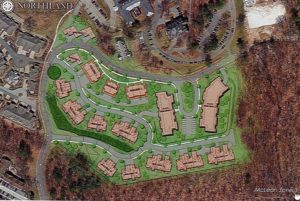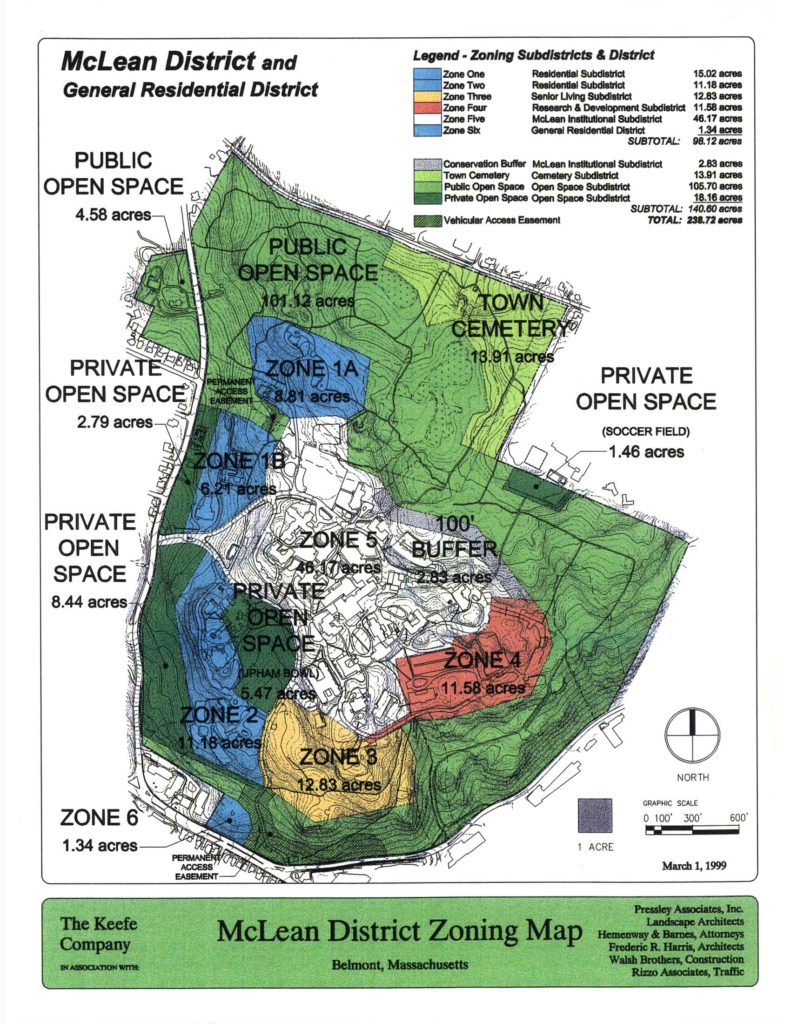Density is key issue as town considers proposals for two McLean campus parcels
By Sue Bass
Twenty years ago, Belmont voted to allow development on McLean Hospital land on Belmont Hill. The town-wide referendum of July 1999 endorsed the previous Town Meeting vote to change zoning for 238 acres. The largest portion for new construction became the Woodlands, 121 luxury townhouses on twenty-six acres. Another portion became Waverley Woods, 40 units of affordable housing on an acre and a third. Some land was preserved from construction. One hundred and twenty acres were set aside for open space, and fourteen acres for a municipal cemetery. The land McLean kept for hospital use shrank to 49 acres.
The rest of the space involved more intensive uses, which have never been realized. The rezoning authorized a senior housing complex of 600,000 square feet on 13 acres, and non-hospital research and development (R&D) offices of 150,000 square feet on 12 acres, plus parking for each. The original senior housing developer was American Retirement Corp. They were acquired by Brookdale Senior Living, which a decade ago cancelled its plans to build the giant project. The developer of the R&D complex, ValueRealty, quietly dropped its option on that land about five years ago. Those two zones would have added an enormous amount of traffic to already-clogged Pleasant Street and were the most controversial of the planned changes. The prospect of all that traffic sparked the 1999 referendum campaign to overturn a Town Meeting vote in favor of McLean.

Northland Residential Corp.’s rendering of the proposed 125 units in zone 3 of the McLean property. (Map courtesy Northland Residential Corp.)
Now McLean is joining with the developer of the Woodlands townhouses in coming back to the town with less disruptive proposals for those two still undeveloped parcels. Instead of 482 housing units in a six-story senior complex that would have loomed over Waverley Square, Northland Residential Corp. proposes just 125 residential (not senior) housing units—34 spacious Woodland-style townhouses, and 91 two-bedroom garden-style flats in four-story buildings. Twenty units in the flats buildings would be affordable, where the eligibility criterion is an adjusted household income under about $70,000. That’s a substantial improvement over the previous American Retirement proposal, which offered more affordable units, 30 compared to 20 of Northland’s, but with a higher income threshold—about $100,000 a year at current calculations.
On the 12-acre parcel that was earmarked for R&D, McLean proposes to move some of its current hospital uses, particularly the two schools it now operates, to create a child and adolescent academic and residential campus. Arlington School is a grade 9-12 high school for 40 students; Pathways Academy was started in 2000 to serve people from age 6 through 22 on the autism spectrum. The institutional use would comprise about 75,000 square feet of building space.
One development could wipe out a decade’s worth of town progress in cutting emissions.
The details are not much fleshed out, because McLean needs money from fundraising (and probably from selling the senior complex land to Northland Residential) to plan its campus expansion. McLean also hopes that about 75,000 square feet in that zone will be used for non-hospital research and development.
At a public hearing conducted by the Planning Board about these proposals on March 14, McLean’s chief operating officer, Michele Gougeon, acknowledged that tax revenue for the town was a major goal of approval of the McLean developments and that the town has received no revenue from the two zones not yet developed. She said McLean would negotiate a payment in lieu of taxes for the land it wanted to reclaim for institutional uses and noted that a private R&D complex would pay regular property taxes. Jack Dawley, president of Northland Residential, predicted that his development would yield about $1.6 million a year in property taxes, in addition to one-time permitting fees paid to the town.
Traffic will again be a concern, even if less in the new development than the 1999 version. All of the traffic from the senior living subdistrict (zone 3 in the McLean zoning on the town’s website) and the R&D subdistrict (zone 4), including the added school campus, will come down Olmsted Drive onto Pleasant Street. A vehicle heading west toward Trapelo Road will join 22,177 others now traveling there daily, according to a study of existing traffic conducted for the town last year. Heading east, it will join 17,588 daily en route to Arlington or 21,122 in Belmont Center. These streets are already overflowing.

Zones 1A, 1B, and 2 comprise the Woodlands townhouse complex. Zone 3, currently zoned for a senior living subdistrict, would be rezoned for more townhouses and for garden-style units. Zone 4, the R&D subdistrict, would be the McLean schools plus a smaller R&D facility. (Map courtesy of The Keefe Company)
Asked about traffic by Town Meeting members Fred Paulsen and Jeanne Mooney, Gougeon said the hospital believes the effects will be minimal. School traffic would move from Mill Street, which she notes is jammed, to Pleasant Street, but she said it is mostly in off-peak hours. Rather than fill the vacated school buildings nearer Mill Street with new traffic-generating uses, Gougeon said the hospital hoped to repurpose a number of its buildings for more efficient use.
Roger Colton, as chair of the town’s Energy Committee, asked that the process be slowed down; the proponents had hoped it could be voted on at the spring Town Meeting, yet they had not yet discussed their plans for energy use. Colton said the two biggest generators of carbon emissions in town are buildings and transportation. One development could wipe out a decade’s worth of town progress in cutting emissions, he noted. Colton and Town Meeting member Roger Wrubel both asked that all buildings be designed for zero net energy use, as the new high school will be. Colton pointed out that traffic and parking are also major factors in emissions.
The town needs 310 more affordable units to eliminate the threat of housing being imposed under Chapter 40B of state housing law, which requires 10 percent of a community’s housing to meet certain affordability standards.
Gary Simon, a resident of zone 2 in the Woodlands, said he thought the new zone 3 would be too dense. Northland Residential proposes about twice as many units as zone 2 (part of the present townhouse complex) has on about the same amount of land, and zone 2 is so tight that the community doesn’t have a good place to pile snow, he said.
Many additional speakers pointed out the need for more affordable housing in Belmont. Rachel Heller of the Affordable Housing Trust said the town needs 310 more affordable units to eliminate the threat of housing being imposed under Chapter 40B. That’s what happened with the Royal Belmont development near Alewife, which was approved by the state over town opposition. (Chapter 40B of the state housing law requires that 10 percent of a community’s housing meet certain affordability standards; Belmont’s does not.)
Density is linked to transportation, several people pointed out. A denser development might produce more traffic, but it can also make public transportation more practical.
Several speakers said the proposal would require rewriting the zoning language and revising the town’s Memorandum of Agreement with McLean. The language proposed by McLean and Northland Residential would have added their desired uses but not erased 20-year-old wording that authorized, for example, 480 units and more than 600,000 square feet of construction in zone 3. Thayer Donham, a member of the Planning Board, said that the existing language allowed both zones 3 and 4 to have 350 outdoor parking spaces, in addition to garage spaces.
Steve Pinkerton, also a Planning Board member, noted, “This won’t pass (Town Meeting) by a two-thirds majority,” as zoning changes must. Action was put off, probably until fall. Expect many more meetings with many more committees in the next few months.
Sue Bass is cofounder and director emerita of the Belmont Citizens Forum and a longtime Town Meeting member. She chaired the unsuccessful 1999 referendum campaign on the rezoning of McLean Hospital land.


Sorry, the comment form is closed at this time.